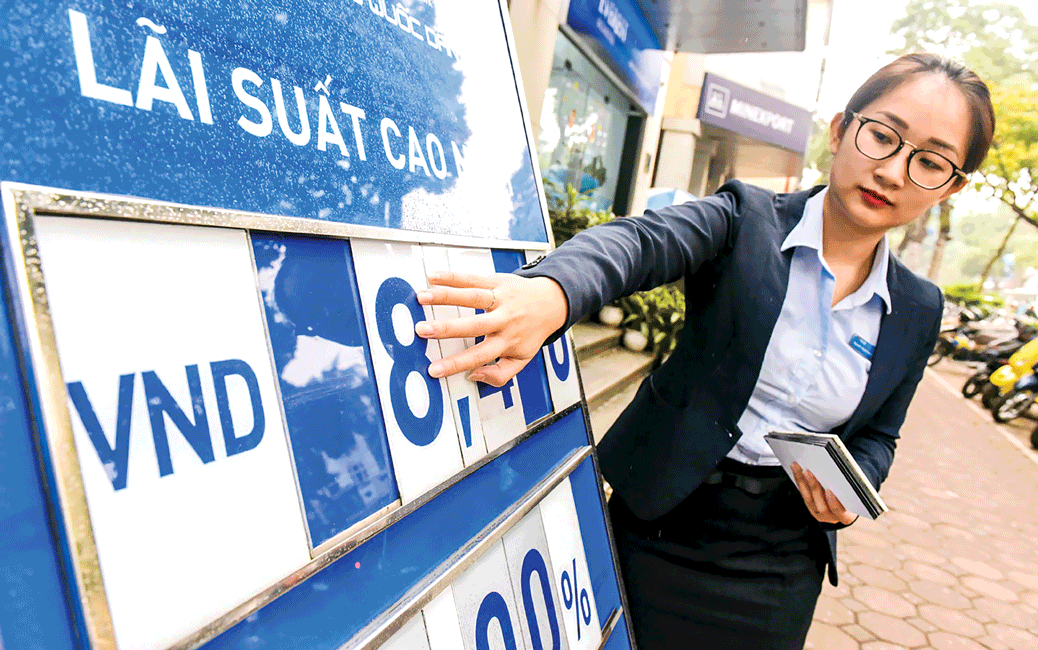
This roadmap is aimed at reducing pressure on commercial banks, which will be better able to lower their interest rates. But in order to do this, banks have to increase long-term mobilization of capital to reduce margin of deposit and loan maturity, which will negatively affect interest rates.
SBV continuously adjusts ratio
Up until now, the Vietnam financial market has been known for imbalances in providing capital to the economy, through both capital market and money market. Commercial banks must supply medium and long-term capital, while they mainly mobilize only short-term capital. In addition, banks cannot arbitrarily withdraw loans before maturity, while depositors have the right to withdraw deposits at any time. The difference in maturity of input and output does not allow banks to have enough cash to pay for capital withdrawal needs. In order to balance credit demand and minimize risk to the system, the ratio of short-term capital used for medium and long-term loans has been continuously adjusted by the State Bank.
Specifically, the ratio of short-term funding for medium and long-term loans was applied at 30% a few years ago, from 2009 to 2014. But from 2014, credit output has encountered many difficulties and the demand for medium and long-term loans is high. In February 2015, SBV raised this rate to 60% at the recommendation of banks. Then SBV continued to adjust this ratio to 50% in 2017, 45% in 2018 and 40% in 2019. Recently, SBV issued Circular 22/2019 for setting limits and maximum rates. Majority of short-term funding for medium and long-term loans will continue to decline, from 1 January to 9 September 2020 the rate will be at 40%; from 1 October 2020 to 30 September 2121 it will be 37%; from 1 October 2020 to 30 September 2021 it will be 34%; and from 1 October 2022 it will be 30%.
According to many experts, a limit in reduction rate according to the above schedule is necessary to prevent a situation where banks use a lot of short-term capital for medium and long-term loans. Currently, part of medium and long-term lending pressure has been transferred to the stock market and corporate bond channel. The above regulation is expected to promote businesses to operate with their equity, or find medium and long-term capital through bonds or shares, instead of bank loans. If banks still want long-term loans, they will have to increase medium and long-term capital to reduce the difference in maturity.
Help market function better
In theory, if banks have less pressure on medium and long-term loans, they will improve operations as well as reduce stress on capital mobilization. Thus, when the roadmap of reducing short-term capital for medium and long term loans is extended to three years, it will also create favorable conditions for reducing interest rates, especially interest rates for mobilizing medium and long-term loans at small banks with liquidity problems. Circular 22 also increased the coefficient of business risks and real estate loans. Accordingly, the scale of real estate loans will be limited because lending rates in this sector will increase, helping the market to be more balanced. As such, this is a macro tool to help the market function better.
However, in practice, Circular 22 will affect medium and long term interest rates in the next few years, as commercial banks still prefer medium and long term loans. Financial statements for the first nine months of 2019 show that currently 13 banks have medium and long-term loans accounting for more than 50% of total outstanding loans. Typically, medium and long-term loans of VIB account for 82.32% of total loans; LienVietPostBank account for 75%; OCB account for 68.92%; TPBank account for 68%; VPBank account for 64.91%; and Techcombank account for 63%. The reason is that long-term loans always have higher profit margins, greatly contributing to bank revenue.
The fact that banks still prefer medium and long-term loans, while the new regulations require that with VND 100 of short-term mobilized capital the bank can only use VND 40 for lending and will gradually decrease to VND 30. Surely banks will continue to increase long-term mobilization, issuing certificates of deposit, bonds to restructure the term, meeting the requirements on the ratio as well as the capital source for lending. The types of mobilization are always competitive, so the interest rates are higher than normal deposits. In addition, banks always keep the lending interest rates 3-4% higher than the input rates to ensure profitability. Therefore, lowering interest rates in mobilizing capital seems unlikely.
According to market analysts, if the medium and long-term capital channel in Vietnam does not catch up with international practices so that businesses can easily seek finance from the bond and stock markets, banks cannot give up medium and long term credit. If these two financial instruments do not fully function, banks will continue to look for long-term inputs to lend, meaning that the interest rate reduction will continue to be just as difficult as has been before.




















